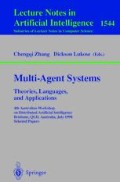Abstract
As software agents are developed to achieve tasks more autonomously, they will need to provide to their users reports about their activities. In the LASOREP Project we aim at developing reporter agents capable to report about the activities of other agents. In this paper we present an agent model that differentiates three components: a temporal model that simulates an agent’s experience of the passing of time, the memory model that records the explicit mental attitudes the agent is aware of, and the attentional model containing the knowledge structures that the agent can manipulate for its reasoning and planning activities. This agent model will provide a basis on which the LASOREP system will be built.
This research is sponsored by the Natural Sciences and Engineering Council of Canada and FCAR.
Access this chapter
Tax calculation will be finalised at checkout
Purchases are for personal use only
Preview
Unable to display preview. Download preview PDF.
References
Allen, J.F.: Maintaining Knowledge about Temporal Intervals. Communications of the Association for Computing Machinery 26(11) (1983)
Cohen, P.R., Levesque, H.J.: Rational Interaction as the Basis for Communication. In: Cohen, P.R., et al. (eds.), pp. 221–255 (1990)
Cohen, P.R., Morgan, J., Pollack, M.E.: Intentions in Communication. MIT Press, Cambridge (1990)
Duc, N.H.: Logical omniscience vs logical ignorance: on a dilemma of epistemic logic. In: Pereira, C.P., Mamede, N. (eds.) Proceedings of EPIAS 1995. LNCS (LNAI), vol. 990, pp. 237–248. Springer, Heidelberg (1995)
Emerson, E.A.: Temporal and modal logic. In: van Leeuwen, J. (ed.) Handbook of Theoretical Computer Science. North Holland, Amsterdam (1990)
Fagin, R., Halpern, J.Y., Moses, Y., Vardi, M.Y.: Reasoning about Knowledge. The MIT Press, Cambridge (1996)
Haddadi, A.: Communication and Cooperation in Agent Systems. LNCS, vol. 1056. Springer, Heidelberg (1996)
Kripke, S.: Semantical considerations on modal logic. Acta Philosophica Fennica 16, 83–89 (1963)
Microsoft, ActiveXTM Technology for Interactive Software Agents (1996), http://www.microsoft.com/intdev/agent/
Moore, R.C.: Logic and Representation. In: CSLI Lecture Notes, vol. 39 (1995)
Moulin, B.: Temporal contexts for discourse representation: an extension of the conceptual graph approach. Journal of Applied Intelligence 7(3), 227–255 (1997a)
Moulin, B.: The social dimension of interactions in multi-agent systems. In: Lukose, D., Zhang. C. (ed.) Proceedings of the Australian Workshop on Distributed Artificial Intelligence DAI 1997. LNCS (LNAI). Springer, Heidelberg (1998) (to appear)
Moulin, B., Brassard, M.: A scenario-based design method and environment for developing multi-agent systems. In: Lukose, D., Zhang, C. (eds.) First Australian Workshop on DAI. LNCS (LNAI), vol. 1087, pp. 216–231. Springer, Heidelberg (1996)
Moulin, B., Rousseau, D., Lapalme, G.: A Multi-Agent Approach for Modelling Conversations. In: Proceedings of the International Conference on Artificial Intelligence and Natural Language, Paris, pp. 35–50 (1994)
Nwana, S.H.: Software agents: an overview. Knowledge Engineering Review 11(3), 1–40 (1996)
Pollack, M.E.: Plans as complex mental attitudes. In: Cohen, P.R. (ed.), pp. 77–103.
Rao, A.S., Georgeff, M.P.: Modeling rational agents within a BDI architecture. In: Proceedings of KR 1991 Conference, Cambridge, Mass, pp. 473–484 (1991)
Sowa, J.F.: Conceptual Structures. Addison Wesley, Reading (1984)
Wooldridge, M.J., Jennings, N.R.: Agent theories, architectures and languages. In: Pre-proceedings of the 1994 Workshop on Agent Theories, Architectures and Languages, ECAI 1994, pp. 1–32 (1994)
Author information
Authors and Affiliations
Editor information
Editors and Affiliations
Rights and permissions
Copyright information
© 1998 Springer-Verlag Berlin Heidelberg
About this paper
Cite this paper
Moulin, B. (1998). An Awareness-Based Model for Agents Involved in Reporting Activities. In: Zhang, C., Lukose, D. (eds) Multi-Agent Systems. Theories, Languages and Applications. DAI 1998. Lecture Notes in Computer Science(), vol 1544. Springer, Berlin, Heidelberg. https://doi.org/10.1007/10693067_8
Download citation
DOI: https://doi.org/10.1007/10693067_8
Publisher Name: Springer, Berlin, Heidelberg
Print ISBN: 978-3-540-65477-3
Online ISBN: 978-3-540-49241-2
eBook Packages: Springer Book Archive

